It's all about ...
plants

Glacier Peak Mountain Hemlock
Tsuga mertensiana 'Glacier Peak'
Height: 10 feet
Spread: 8 feet
Sunlight:
![]()
![]()
Hardiness Zone: 5a
Brand: Iseli Nursery
Description:
A garden sized hemlock with an alpine appearance; soft blue-green needles have a silver cast; has a consistent upright habit with a rugged, irregular look; needs adequate moisture, rich, acidic and organic soils and shelter from drying winds
Ornamental Features
Glacier Peak Mountain Hemlock is a dwarf conifer which is primarily valued in the landscape or garden for its ornamental upright and spreading habit of growth. It has attractive powder blue-variegated bluish-green foliage with hints of silver. The small sprays of foliage are highly ornamental and remain bluish-green throughout the winter. The brick red fruits are held in cones in mid fall.
Landscape Attributes
Glacier Peak Mountain Hemlock is a multi-stemmed evergreen shrub with an upright spreading habit of growth. It lends an extremely fine and delicate texture to the landscape composition which can make it a great accent feature on this basis alone.
This shrub will require occasional maintenance and upkeep, and is best pruned in late winter once the threat of extreme cold has passed. Gardeners should be aware of the following characteristic(s) that may warrant special consideration;
- Insects
Glacier Peak Mountain Hemlock is recommended for the following landscape applications;
- Mass Planting
- Rock/Alpine Gardens
- General Garden Use
Planting & Growing
Glacier Peak Mountain Hemlock will grow to be about 10 feet tall at maturity, with a spread of 8 feet. It has a low canopy, and is suitable for planting under power lines. It grows at a slow rate, and under ideal conditions can be expected to live for 70 years or more.
This shrub does best in full sun to partial shade. It does best in average to evenly moist conditions, but will not tolerate standing water. It is particular about its soil conditions, with a strong preference for rich, acidic soils. It is quite intolerant of urban pollution, therefore inner city or urban streetside plantings are best avoided, and will benefit from being planted in a relatively sheltered location. Consider applying a thick mulch around the root zone in winter to protect it in exposed locations or colder microclimates. This is a selection of a native North American species.
This plant is not reliably hardy in our region, and certain restrictions may apply; contact the store for more information.
